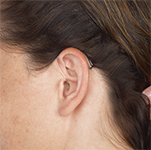These aren’t your grandfather’s hearing aids. Sound familiar? Digital hearing aid technology has revolutionized the capabilities, size, and sleekness of hearing aids.
Today, you can find hearing aids that are small enough to fit so deep within the ear canal that they’re effectively invisible. Other models offer enough features to rival the latest smartphones. There are more choices than ever for people shopping for hearing aids, and our professionals are experts at walking you through the options that would best serve your unique needs and preferences.
Hearing Aid Styles
There are hearing aid models to help every type and level of hearing loss, meet every budget, and suit a wide range of aesthetic preferences. This wide range of options falls into two types of styles: Behind-the-ear (BTE) and In-the-ear (ITE). Below is an overview of these styles. In the end, the best hearing aid for you will address your unique hearing ability, lifestyle, and budget.
Behind-the-ear (BTE) Hearing Aids
BTE hearing aids sit behind or on top of the outer ear with a tube that connects to an ear tip or mold inside of the ear canal. BTE’s offer the widest range of features, colors, sizes, battery types, and degrees of power. Today, they’re offered in small, discreet designs that are often unnoticeable when worn. There are a variety of BTE styles available including:
Mini BTE
Receiver-in-the-ear (RITE) or Receiver-in-canal (RIC)


Mini BTEs are the smallest of the BTEs and equipped with a soft tip at the end of the tubing to enable airflow and sound to enter the ear canal along with the amplified sounds, creating a more natural experience.
RITE hearing aids are designed with the speaker built into the ear tip instead of the main body of the hearing aid. They are slightly larger than Mini BTEs but are still relatively unnoticeable when worn.
BTE with Earmold

BTEs with Earmolds are designed with a custom earmold at the tip of the discrete tubing directing sound into the ear canal. These have a longer shape that follows the contour of the outer ear and enables them to house more features and power.
In-the-ear (ITE) Hearing Aids
ITE hearing aids are worn in the ear instead of resting behind it, and are custom-fit based on an impression of the ear. There are a variety of ITE styles available including:
Invisible in-the-canal (IIC)
Completely in-the-canal (CIC)


IIC instruments are the smallest custom hearing aids available. They sit deep within the canal and are nearly invisible to the naked eye.
CIC instruments fit into the ear canal, but not as deeply as the IIC models. Slightly larger than the IIC, they are still relatively hard to see.
In-the-canal (ITC) or Half Shell
In-the-ear (ITE) or Full Shell


ITC instruments sit in the lower portion of the outer ear bowl. Since they are slightly larger than the CIC, they are able to hold additional features, including a larger battery, directional microphones, and volume controls.
ITE instruments fill the entire outer ear bowl. Their larger size allows for more features and functions, including a larger battery, directional microphones, volume controls, and larger receivers for more severe hearing losses.
Wireless Connectivity: Bluetooth Hearing Aids, Smartphone Apps, and More
Perhaps the most promising advancements in hearing aid technology involve their ability to connect wirelessly (using Bluetooth technology) to our favorite devices. Made for iPhone® hearing aids and other wireless hearing aids that connect with everything from iPads® to televisions are on the rise—effectively making wearing hearing aids easier than ever.
Gone are the days of fiddling with the hearing aid itself to adjust the volume or listening programs. Modern Bluetooth hearing aids include associated apps (software applications) that enable wearers to access their hearing aid settings from the convenience of their smartphones (iPhone® and Android® models), iPads®, and smartwatches. These apps enable discreet and easy adjusting of the long list of hearing aid settings to make for the most comfortable listening experience in any environment—with just a few clicks on a screen. Certain models of wireless hearing aids are even able to sense your sound environment and automatically adjust to your surroundings based on your unique preferences.
Phone conversations have also been vastly improved with Bluetooth hearing aids, removing the potential for the annoying feedback often associated with bringing a phone near a traditional hearing aid. Instead, this technology enables phones to stream to hearing aids, providing the easiest and clearest phone conversations available. Advanced wireless connectivity also means that television, music, podcasts, audiobooks, or any other audio from your devices can now stream directly to your hearing aids, providing unparalleled sound clarity. Wireless hearing aids can even double as a high-definition headset to create the most natural-sounding listening experience possible for wearers.
This is an exciting time in hearing technology development and advancements occur rapidly. Be sure to ask us which models of hearing aids offer these types of features and we’ll be happy to walk you through what the latest technology has to offer.
Which Hearing Aid is Right for You?
With the ever-growing list of options these days, selecting the best hearing aid for your needs can seem daunting. Many factors will determine the best model of hearing aid for you, including your unique hearing ability, lifestyle requirements, budget, and preferences for specific features and styles. At Audiology Associates of NJ we’re experts at making this an easy and straightforward process so you can find a hearing aid that best suits you.
Finding the right hearing aid for your needs begins with a thorough hearing evaluation. Once we uncover your specific hearing requirements, we can help you select the pair of hearing aids that will reconnect you with vibrant sounds again.
